Belfast WwTW (2022)
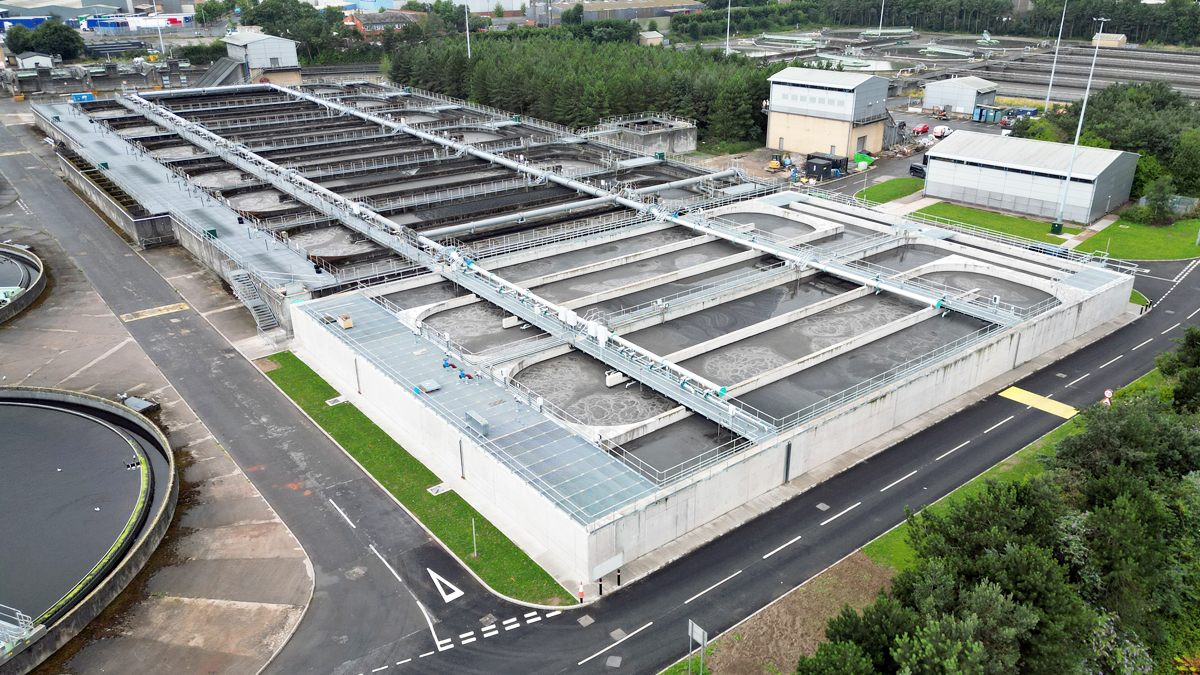
Completed Belfast STW ASP tanks - Courtesy of NI Water
Situated close to the shores of Belfast Lough, Belfast Wastewater Treatment Works (WwTW) is Northern Ireland’s largest wastewater treatment plant, serving most of the City of Belfast. It occupies a large 45-acre site within Duncrue Industrial Estate and was designed to treat a domestic and trade population equivalent (PE) of 290,000 with discharge into Inner Belfast Lough; most of which is a Special Protection Area and over 40% of which is a Shellfish Water Protected Area. The current process units were built in the 1990s to replace the original works, which dated back to the early 1900s. NI Water is initially investing almost £10m at the treatment works (Phase 0) to ensure compliance with the existing discharge standard. Planned subsequent phases will upgrade the works to achieve future more stringent standards.
Background
The Belfast WwTW Phase 0 Project is one of the first capital delivery projects within the £1.4bn Living With Water Programme (LWWP), a forward-thinking initiative established in 2015 to develop and deliver integrated catchment-based drainage and wastewater projects across Greater Belfast to protect against flooding, enhance the water environment and provide the increased capacity necessary for economic growth.
The existing works
Belfast WwTW is located within the industrial/docks area of Belfast Harbour Estate. It was constructed between 1991 and 1999 to replace the original Victorian works.
Belfast WwTW was designed to serve a PE of around 290,000 (with redundancy) and is contained within a site area of approximately 180,000m2. The WwTW is required to provide secondary biological treatment based on a conventional activated sludge process (ASP) prior to discharge into Inner Belfast Lough.
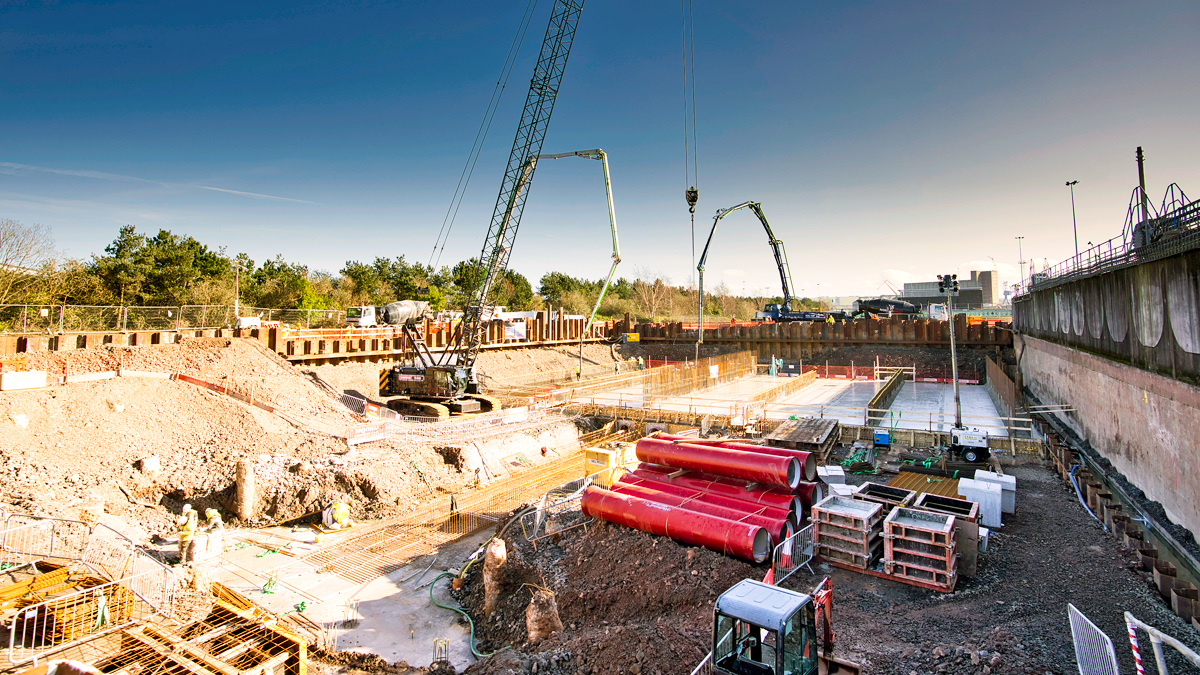
Belfast WwTW: Progress March 2021 – Courtesy of NI Water
Wastewater treatment at the site comprises screw pumps, fine screening, grit removal, 8 (No.) primary settlement tanks, 6 (No.) aeration (activated sludge) tanks and 12 (No.) final settlement tanks. Non-process facilities relating to NI Water’s administrative building, Bretland House; their educational facility known as The Wastewater Centre and the Belfast Terminal Storm Pumping Station also occupy space within the existing site. The works also receives five waste streams from the nearby incinerator site and tankered trade effluent from several traders.
Belfast WwTW is currently treating average loads in excess of 400,00PE. All plant redundancy is being fully utilised and all process elements are at maximum capacity. The plant is running at elevated mixed liquor suspended solid levels which is putting the process at higher risk of solids loss. The works is currently meeting its discharge consent through extensive interventions by NI Water operational staff and implementation of a Risk Mitigation and Action Plan.
Project drivers/need for investment
Belfast WwTW is severely overloaded; treating a far greater load than it was designed for. Since the summer of 2016, the plant has had all six aeration tanks in service and as such, all redundancy is now fully utilised. As a result, the WwTW was assessed to be at high risk of future non-compliance and new connections/development in the catchment have been restricted. There is a high risk of significant operational issues during periods of routine maintenance and breakdowns. For example, due to the lack of headroom within the treatment process, changing the fine bubble diffusers within the ASP tanks, which are at the end of their design life, becomes extremely difficult to undertake.
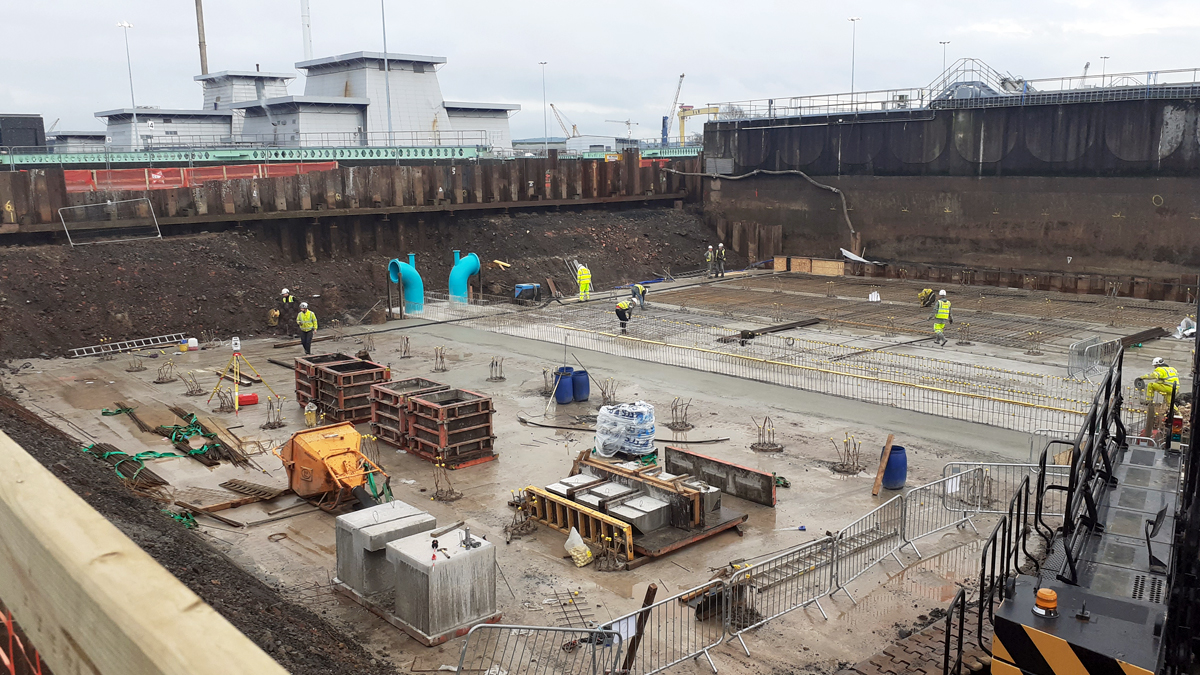
Construction of the base slab – Courtesy of NI Water
Early contractor involvement/design and build contract
MDWAM JV and joint venture between Murphy and DAWSON-WAM Ltd was appointed by NI Water in February 2020 under an Early Contractor Involvement (ECI) contract. The ECI phase allowed MDWAM to develop options with the project management team from McAdam and NI Water at an early stage. This proactive approach led to enhanced collaboration, value engineering and greater efficiency for the project. It also enabled the team to work together to identify the best approach for delivery during the COVID-19 pandemic.
Belfast WwTW: Project team & supply chain – key participants
- Main contractor: Murphy DAWSON-WAM Ltd (MDWAM) JV
- Project management: McAdam
- Civil & structural design: RPS
- Piling contractor: DAWSON-WAM Ltd
- Ductile iron pipework: APP Fusion Group
- Isolation & air control valves: Flow Technology Services
- Air blowers: Sulzer Water & Wastewater
- Pumps, mixers & diffusers: Xylem Water Solutions
- Instrumentation: Park Electrical Services
Phase 0 works
To meet the project needs, a £10m programme to construct two new 7.5ML capacity treatment tanks was identified by the NI Water team as the preferred solution for the site. Construction works got underway in October 2020, with project management support ongoing from McAdam.
Located beside the six existing tanks, two new ASP tanks are being constructed next to each other, sharing a dividing internal wall. Provision was made in 1990s for the extension of the existing process. The combined dimensions of the new tanks are 65m by 43m and they are approximately 8m deep; providing a process volume equivalent to six Olympic-size swimming pools.
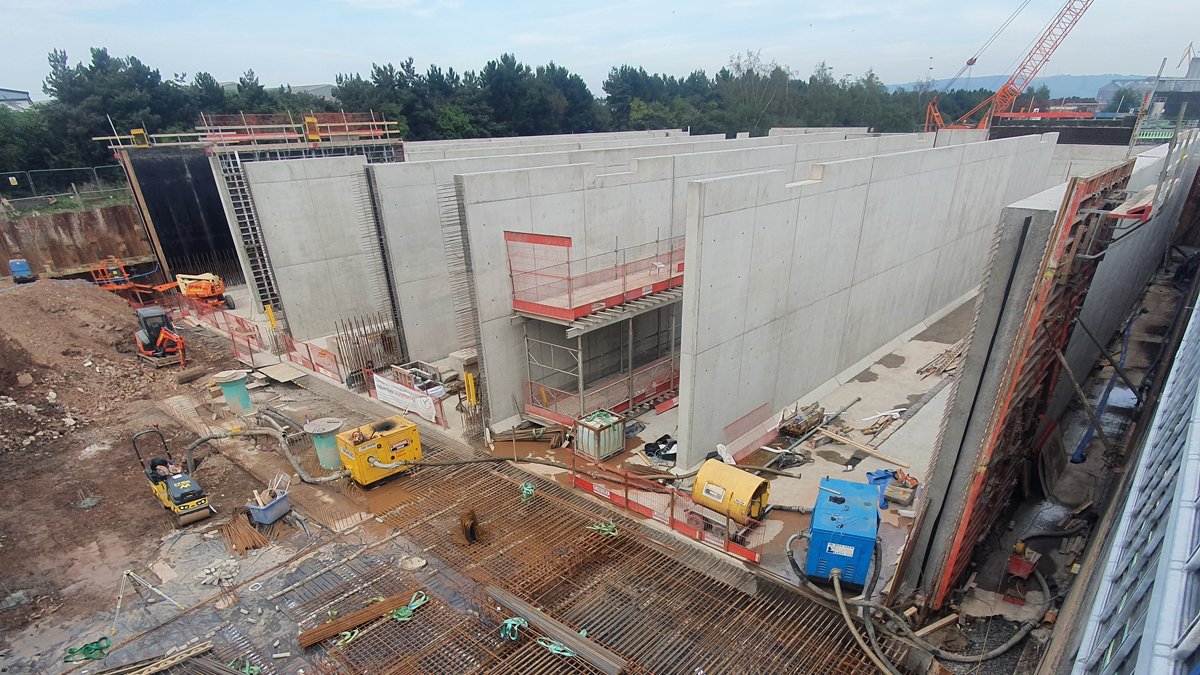
Belfast WwTW: Progress September 2021 – Courtesy of NI Water
Challenges
One of the main challenges for the Belfast WwTW Phase 0 Project was the ground conditions as the original works was built in an area of Belfast which was reclaimed from the sea.
DAWSON-WAM Ltd are specialist civil engineering and piling contractors and during the ECI process they scoped and undertook detailed site investigations to enable suitable foundation for the tanks to be designed. In total 201 piles were installed. These piles were 525mm diameter continuous flight augur piles with a safe working vertical load capacity of 1,800kN and a safe working tension load capacity of 150kN. To prevent the ingress of groundwater into the excavation, a cofferdam using sheet piles was constructed in and around the new tanks; groundwater was then controlled locally. Once the cofferdam was removed, the self-weight of the structure – combined with the tension capacity of the piles – resisted the hydrostatic uplift forces generated by the groundwater.
Due to space limitations and the need to maintain operational access to Belfast WwTW and the nearby incinerator, frequent communication between the project team, client and incinerator operator was crucial to ensure construction works could be planned and executed in way to minimise disruption.
At time of writing (July 2022) civil works were complete and MEICA works were ongoing, including the installation into the tanks of 5,662 fine bubble diffusers from Xylem Water Solutions. Commissioning was on programme for completion late summer. Following this, work will begin on replacing assets in the existing ASP tanks as part of a NI Water base maintenance programme of works.
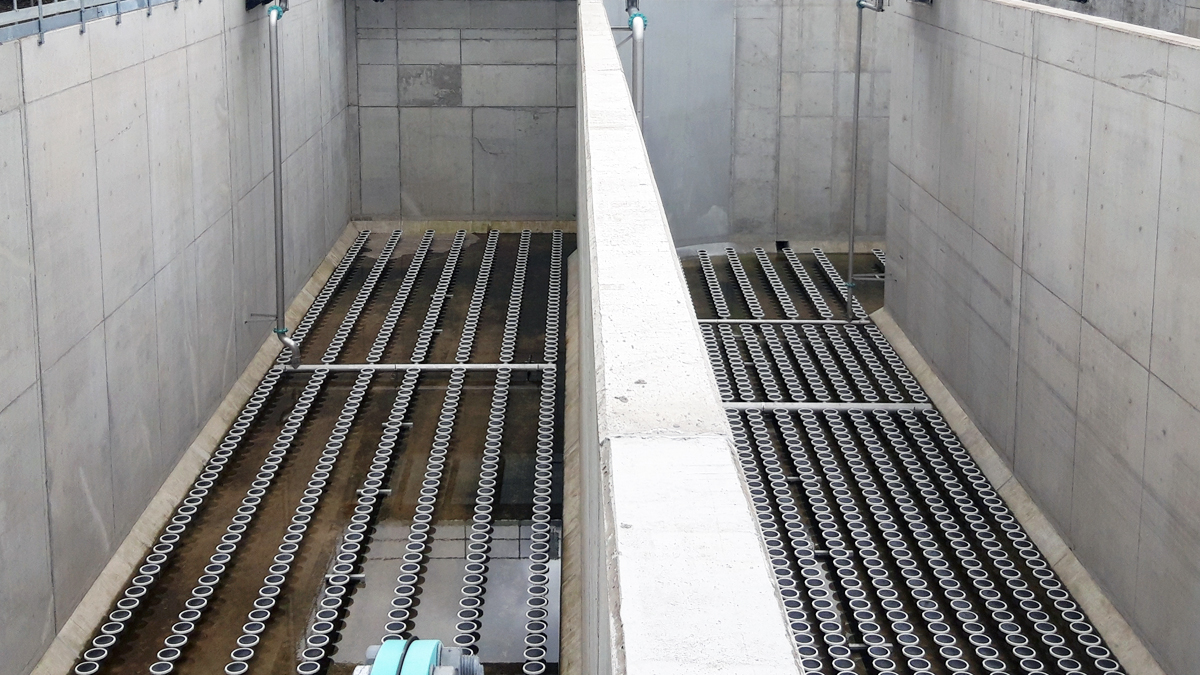
Some of the 5,662 diffusers installed in new ASP tanks – Courtesy of NI Water
Reducing environment impact/future planning
Although the project itself will help reduce the risk of negative impact to the environment the NI Water project team were also conscious of the need to reduce the construction impact of the project. To aid this, material suppliers close to the site were identified to reduce the transportation carbon impacts. Spoil from the excavation was also used to cap a nearby landfill.
In addition, the project has also been designed and planned with maximum flexibility going forward and to ensure the tanks have potential to be reused for future site needs.
During the design process specialist suppliers were engaged, and the tanks were designed in a way that if not used for aeration, they could be used for something else; potentially another biological treatment process or stormwater storage.
Benefits
This £10m NI Water initial upgrade to Belfast WwTW, as part of the Living with Water Programme, will help protect the sensitive waters of Belfast Lough. The two new treatment tanks will provide much needed additional secondary treatment capacity and enable urgent base maintenance works to take place on the existing tanks.
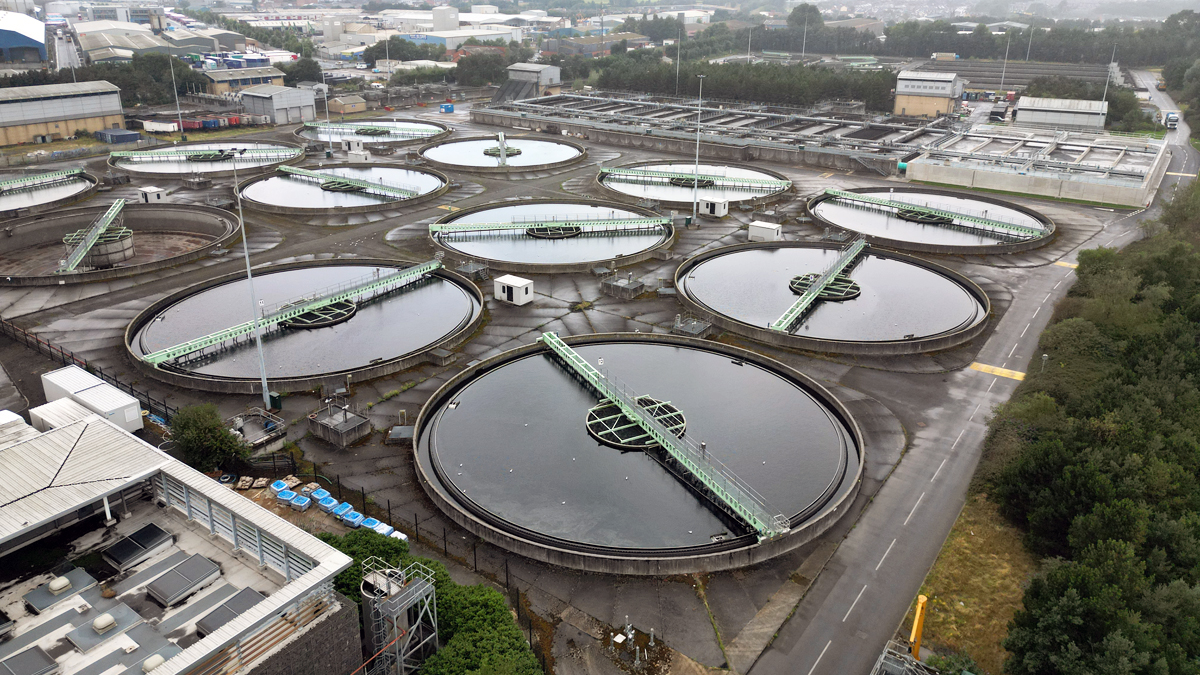
Belfast WwTW July 2022 – Courtesy of NI Water
Once completed, the additional capacity and refurbished assets will help ensure that the discharge to Belfast Lough remains compliant with the current Northern Ireland Environment Agency standards and the extensive work carried out will help support development and aid economic growth in the city.





